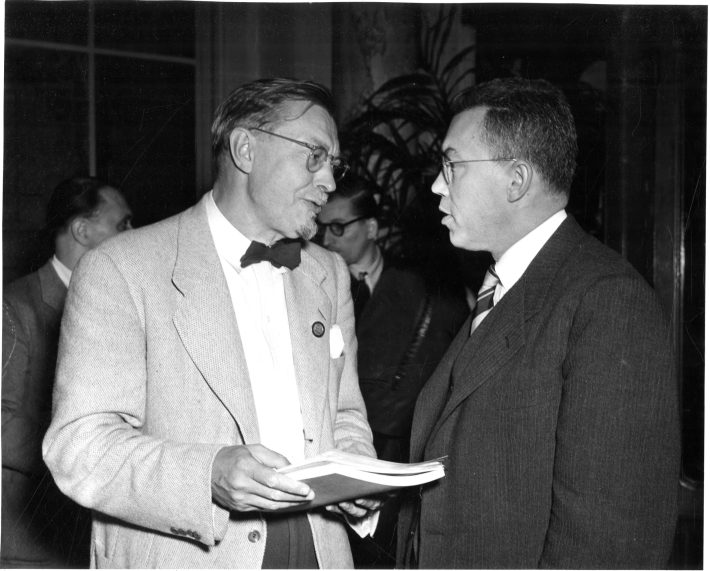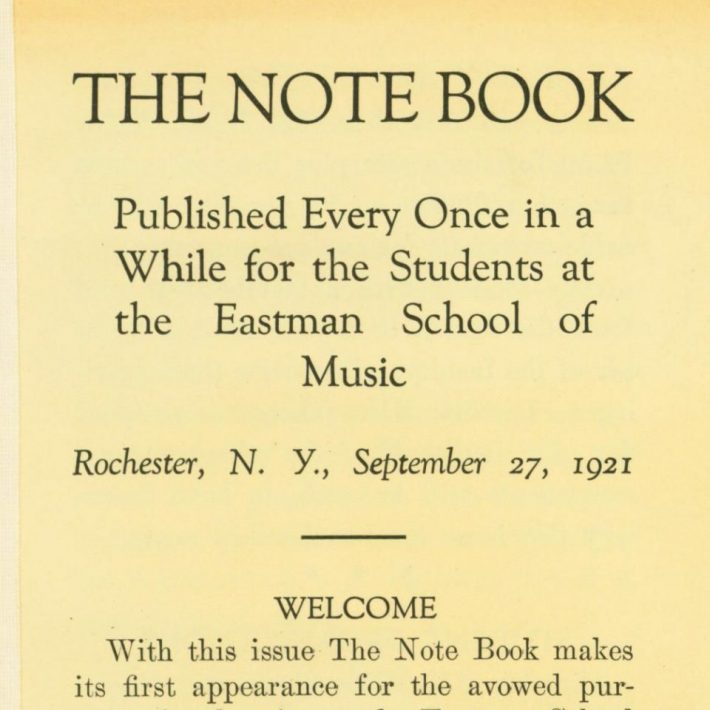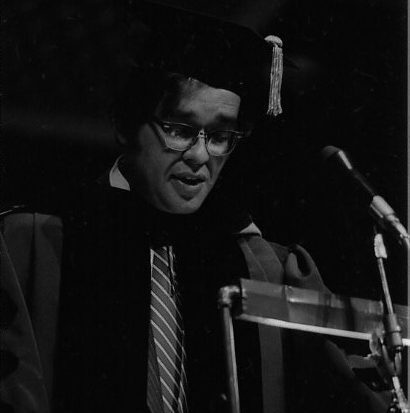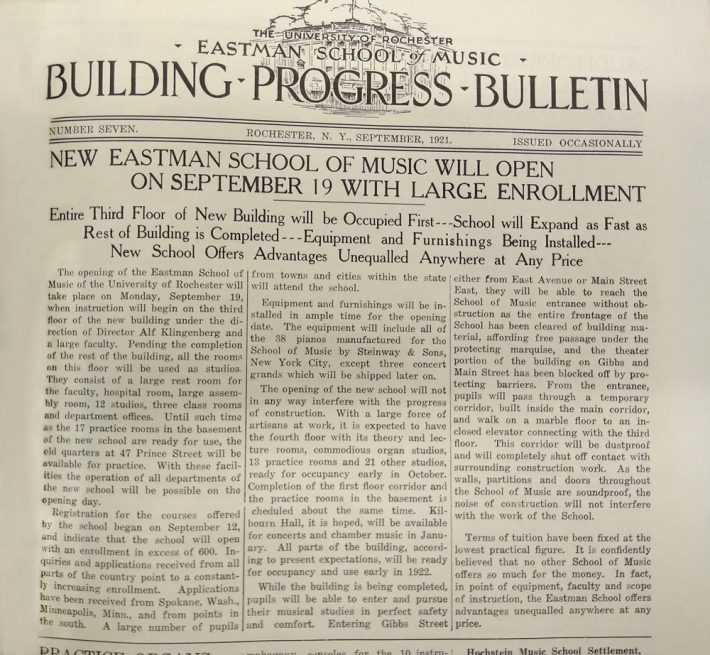1962: Eastman Philharmonia on tour

Sixty years ago this week, the members of the Eastman Philharmonia were more than halfway through their landmark tour of Europe, the Middle East, and the Soviet Union. From January 17th through 23rd, 1962, the 87 orchestra members were in Poland, where they gave concerts in Poznan, Krakow, Warsaw, and Lodz. Based on one member’s travel journal and on Howard Hanson’s later recollections, it is accurate to say that all four of the concerts, each of which featured as many as six encores, were warmly received. Moreover, that warm reception was not limited to inside the concert hall; bassoonist Richard Rodean, BM ’62, MM ’64 recorded in his travel journal that a large crowd gathered outside the hotel in Poznan to wish the orchestra members well before they left the city for Krakow.
In Poland as elsewhere during the tour, Philharmonia members sought out music stores to acquire scores not easily found on the U.S. market, and also to take advantage of favorable exchange rates. The usual routine was to visit a post office afterwards so as to send the newly acquired scores home in parcels. One photo displayed here captures trumpeter John Landis showing Dr. Hanson some of the scores that he had just acquired in Warsaw. To date, RTWSC holds archival collections of three performers who were on the tour; judging by their contents, Soviet music publications were especially sought out for acquisition.



When not involved with the demands of rehearsal and performance, the Philharmonia members spent their time sight-seeing and touring major sites of cultural and historical importance. They were feted with receptions at the U.S. Consulate in Poznan and at the U.S. Embassy in Warsaw, underscoring the diplomatic role that they played in addition to their musical one. Philharmonia members also visited with music students in Poznan and in Warsaw; after those encounters, bassoonist Rodean noted in his travel journal the value of German as a second language in Poland as, indeed, elsewhere during the tour.
The sojourn in Poland was the Philharmonia members’ first leg of the tour behind the Iron Curtain. On the evening before their flight to Poznan they received a briefing advising them on what to expect. Clearing customs in Poland involved, for the first time ever on the tour, each and every suitcase being opened. Upon landing at Poznan, the orchestra members bade farewell to the flight crews of their two chartered DC-6 aircraft, whom they had come to know rather well. For the duration of the tour, all travel would be by local services (bus); air travel into and out of the USSR would be on Aeroflot; travel within the USSR would be by train; and the return flight home would be on KLM. With respect to the tour taking on a different tone once the Philharmonia had left behind Western Europe, I should note that the Eastman Philharmonia files in both Dr. Hanson’s and Dr. Fennell’s professional papers hold copies of official U.S. Government publications for Americans travelling abroad. These publications went so far as to offer suggested responses to “difficult” questions from other nationals abroad about the American way of life and political system and so forth. At a time when the world order was characterized by a division between the capitalist world, the communist world, and the non-aligned countries, the U.S. Government maintained a staunch interest in promoting American values as widely as possible; hence the founding of such initiatives as Voice of America, the United States Information Agency, and the President’s Special International Program for Cultural Presentations, which was the program under which the Philharmonia tour was taking place. Mr. Rodean described in his travel journal some of the most immediately perceived aspects of life in a communist state, such as the jamming of a Voice of America radio broadcast from Munich to which he was listening; but at the same time, his journal captures vividly the warmth and gratitude that Polish audiences extended to the orchestra. His entry for January 20th, 1962, when the Philharmonia performed in Krakow, is worth quoting at length:
“The concert this evening is one for the books. Dr. Fennell conducted the first half, much to the enjoyment of everyone. As a matter of fact, we played the last movement of the Falla twice as an encore before intermission. The audience was with us from the start. We played six encores, including the Beethoven Overture to applause that only ceased when the orchestra literally left the stage. It was an unforgettable sight to see old women who were unable to stand during the ovation wave handkerchiefs in the air; arms were raised high above heads clapping unceasingly. One old man in the balcony barely got to his feet to applaud. He just stood and slowly applauded as best he could. It’s hard to imagine such sincere applause. Hundreds of kids flooded the aisles seeking autographs and handshakes after the concert. A sizable crowd lined the street to the bus and waved as we left for the hotel and a late supper. It seems hard to imagine any differences that should affect such people as this to have any ill feelings towards the U.S. If this is what music and art can do for people where science has failed, then I give thanks that this is my profession. How anyone could question the value of music after such an evening as this is beyond my comprehension.”
►Poland information sheet from the Howard Hanson Collection
At all points in their itinerary, the Philharmonia members received official communications from consular and/or embassy officials regarding the locales in which they were staying. This information sheet (4 pages) briefed the orchestra members on logistics in Poland during their stay.
►Concert program, Poznan, January 17, 1962
►Concert program, Lodz, January 23, 1962
1970: Janet Baker engagement in Kilbourn Hall
Fifty-two years ago this week, on January 17th, 1970, English mezzo-soprano Janet Baker appeared in recital in Kilbourn Hall with her collaborative pianist, Martin Isepp. This would mark the first of Janet Baker’s two Eastman engagements in the early 1970s; the next would be in the fall of 1971, when her recital would mark the first professional guest recital during the Eastman School’s Fiftieth Anniversary Season. Miss Baker performed under the auspices of Hurok Artists, Inc.
Janet Baker (b. 1933) had made her American debut in 1966 when she appeared with the San Francisco Symphony Orchestra under Joseph Krips in a performance of Mahler’s Das Lied von der Erde. Although she would make regular return tours of the U.S., her many professional commitments back home in the U.K. and in Europe limited the number of her American performances. While she has performed and recorded all of the major mezzo-soprano repertory for solo voice, oratorio, and numerous operatic roles, she has been particularly closely associated with the music of Edward Elgar (whose Sea Pictures and The Dream of Gerontius she recorded under conductor John Barbirolli) and Benjamin Britten (whose Phaedra, opus 93 (1976) was composed for her). She has been the recipient of many awards, recognitions, and titles; at the time of her 1970 Rochester engagement, she had just been made a Commander of the Order of the British Empire (CBE). In 1976 she would be appointed to Dame Commander (DBE), and has been styled as Dame Janet Baker since that time.
Reviews of the recital by local critics Theodore Price (Democrat & Chronicle) and George H. Kimball (Rochester Times-Union) are preserved in the Sibley Music Library’s Rochester Scrapbooks. The photographs by Louis Ouzer that are here displayed are indicative of the unfettered access that the Eastman School granted Mr. Ouzer in his being able to go “behind the scenes” and capture the artists in such candid moments.
► Photos by Louis Ouzer. Master negative nos. R808-8, 10, 13, 16




► Janet Baker seen in the green room with her collaborative pianist Martin Isepp and ESM Director Walter Hendl; and one view of the performers on-stage in Kilbourn Hall.
1972: Monster Concert
Fifty years ago this week, on January 17th, 1972, Professor Eugene List and his assembled piano faculty colleagues performed another in his series of so-called Monster Concerts involving a multiplicity of pianos on-stage. Professor List’s affinity for the repertory of Gottschalk was well-known; that composer’s works for two, three, four, and more pianos were generally what were programmed in the Monster Concerts.
Mr. List (1918-1985) served on the Eastman faculty for twenty years (1965-85). He was a staff sergeant in the U. S. Army during World War II, and after the end of the War had been invited to perform (in uniform) for the assembled Allied leaders Truman, Churchill, and Stalin at the Potsdam conference (1945). His performances at Potsdam earned him the reputation of “the Potsdam pianist” for a number of years, and he also enjoyed the personal admiration of President Harry Truman (himself an accomplished amateur pianist), who invited him to perform at the White House.
► photos by Louis Ouzer R1373-2 and -13; R1374-21 and -22.
►These shots capture moments both in performance and in rehearsal in Kilbourn Hall.
1974: Ron Carter returns to Eastman
Forty-eight years ago this week, double bassist Ron Carter, BM ’59, made one of his periodic returns to Eastman. Always a favorite with the Eastman community and with the Rochester audience, Mr. Carter appeared in Kilbourn Hall with guitarist Gene Bertoncini and also, as these photos attest, engaged with students and faculty members in an informal session elsewhere. Mr. Carter’s generosity to the Eastman community has taken several different forms, including a substantial gift of sound recordings to the Sibley Music Library.
► Printed Program
► photos by Louis Ouzer R1875-16A and -30A; R1876-1A, 4A, 13A, 35A.

► These photos demonstrate the close, candid interaction enjoyed by Eastman students with the renowned artist Ron Carter. Such moments are emblematic of what the Eastman experience has to offer.
1983: “A New Morning for the World” premiere
Thirty-nine years ago this week, on January 19th, 1983, the concluding concert of a five-city tour by the Eastman Philharmonia took place in the Eastman Theater. The concerts of that tour were noteworthy for having introduced Professor Joseph Schwantner’s new composition A New Morning for the World to audiences for the first time. The new work had been commissioned by the Eastman School of Music and was scored for narrator with orchestra; the text had been assembled by Mr. Schwantner from several writings, addresses, and speeches of Dr. Martin Luther King, Jr.. The Eastman Philharmonia, under conductor David Effron, performed the work in five different venues on five consecutive nights, with the Eastman Theater performance on January 19th, 1983 marking the conclusion of the tour. A New Morning for the World was recorded for commercial release in a session held two days after the January 19th concert.
The invited narrator for the premiere was Mr. Willie Stargell (1940-2001), a veteran of professional baseball who had played left field and first base for the Pittsburgh Pirates (1962-82). During his years with the Pirates he had famously led the team to victory in the 1979 World Series. Eastman Director Dr. Robert Freeman had actively sought Mr. Stargell’s participation in the Schwantner premiere. Dr. Freeman, himself an avid baseball fan, had become an admirer of Mr. Stargell’s humanity and leadership qualities, in particular his sense of community and civic pride, his admiration for Dr. King, and his advocacy for the Willie Stargell Foundation, which supported research into treatment for sickle cell disease.

1990: Branford Marsalis engagement with the Eastman Jazz Ensemble
Thirty-two years ago this week, on January 20th, 1990, saxophonist Branford Marsalis appeared in concert with the Eastman Jazz Ensemble. Today Mr. Marsalis, a three-time Grammy Award winner, enjoys a worldwide reputation as saxophone soloist and collaborative performer, bandleader, and composer. At the time of this Eastman engagement, Mr. Marsalis was thirty years old and his star was steadily rising. The opportunity for Eastman students to perform with such a brilliant artist is emblematic of what makes the Eastman school the unique educational experience that it is. Louis Ouzer’s photos capturing Mr. Marsalis with Eastman students in rehearsal further underscore the advantages afforded Eastman students by enjoying candid interactions with the best.
► printed program
► photos by Louis Ouzer R3847-10, -14, -22; R3849-20 and -24.









































